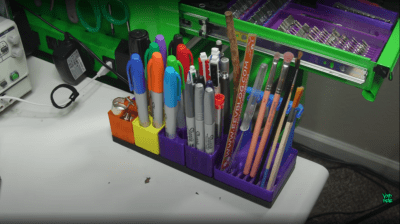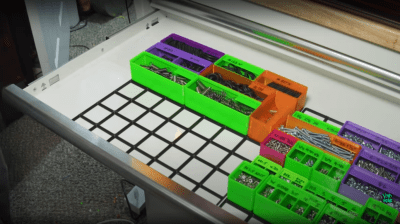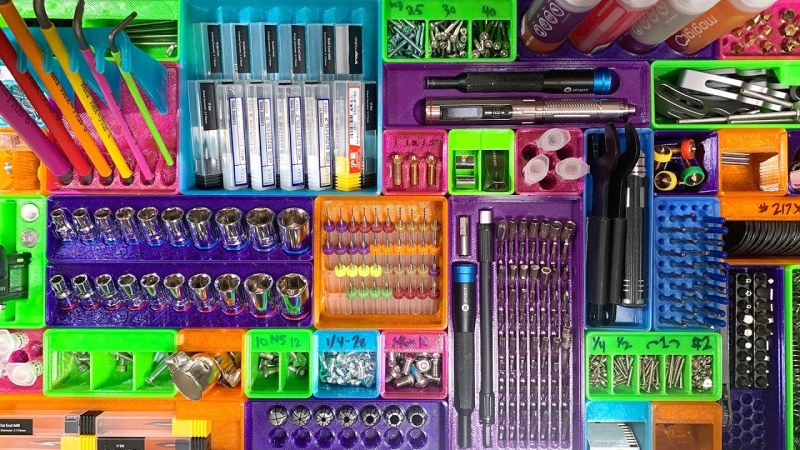Our favourite cyborg [Zack Freedman] has been stumbling over a common problem many of us will be all too familiar with — that of tool storage and the optimal retrieval thereof. His solution is the Gridfinity: A modular workshop organisation system.

In [Zack]’s words, the perfect workshop has tools and materials arranged in the following way: (a) every item has a dedicated home within reach of where you’ll use it. (b) items are exposed and in position for instant grabification. (c) the storage system shields you from accidents like spills and injuries. (d) it is effortless to setup and easy to put back and rearrange. An instant-access storage solution such as the Gridfinity is designed not to help you store more stuff, but finish more projects. The idea is very simple — display your stuff so that you can quickly find what you need and get back to the project as quickly as possible. We think these aims are pretty spot on!
From an implementation perspective, the system consists of a 3D printed base plate with a grid structure. It is angled internally so storage bins drop in, but are not easy to knock out. Storage units drop into the grid in various sizes and orientations, such that everything is contained within the grid’s outer boundary, so the whole assembly will fit inside a drawer with ease. Small part storage bins have a curved inner surface enabling one to easily scoop out a part when required. A partial lid on the top allows them to be stacked vertically if required.

Whilst the system is work in progress, there are still about a hundred different storage units, for anything from 3D printer nozzles to racks for tweezers. Implemented as parameterised models in Fusion360, it is easy to tweak existing models for your stuff, or create totally new ones, from the supplied templates.
No discussion of tool organisation would be complete without first considering the king of tool organisation [Adam Savage], the principle of first order retrieval is a strong one. For a more in-your-face solution, you could go down the pegboard-on-wheels route, or perhaps if you’re less mobile and in a tight squeeze, then get comfortable with the French cleat and build something full custom right into the walls. Whatever solution you come up with, do share it with us!
















Can I get the key dimensions and re-do it in OpenSCAD? kthxbye!
My thoughts exactly! Please do share if you do this!
I found this, but I think OpenSCAD would be better:
https://www.printables.com/cs/model/170956-basic-gridfinity-baseplates-cadquery-customizable
Does Zack read Hackaday?
I am the creator of the CadQuery model you linked to, and I believe CadQuery is a better choice because it is far better at creating fillets not to mention the fact that CadQuery is also open source and based on python and thus has a much better programming language than OpenSCAD. I do like OpenSCAD, and have released many designs in it — but the limitations can be maddening.
I’ve seen him reply from time to time
Oh, hai.
So, uh, could you publish the dimensions please? I don’t mind printing pre-digested output from Fusion, but the information is basically locked up in there, and inaccessible if you don’t have Fusion.
I started an OpenSCAD one, but not sure how far I will get. So far just a basic cup, but it’s a start.
https://www.printables.com/model/174346-gridfinity-openscad-prototype
He talks about all of the key dimensions in the video and why he chose them. Definitely would have liked to have seen this in FreeCAD. It’s ‘open source’ though, so I guess we could just remodel it, although can it really be open source if you have to install a commercial package to access it? I do believe he has stl’s available though.
Yes, but if I don’t have the details of the flanges and fillets I’m not going to be able to reproduce it exactly.
Ok. I am using the online Fusion 360 viewer to get dimensions from the template model. So far, the outer measurement is 42×42 mm, with a 4mm corner radius, and the screw holes are 3mm on 26mm centres.
That was tedious. I have completed the base. Now I need the clearance between the base and the grid, then I can do the grid, and programmatically do it any size.
https://www.printables.com/cs/model/170956-basic-gridfinity-baseplates-cadquery-customizable
I released a redesign in an open source CAD software called CadQuery at the link above. The model is fairly complicated but I reproduced the dimensions within 0.01mm.
“although can it really be open source if you have to install a commercial package to access it?”
Definitely yes. Open Source/Free Software predates non-commercial compilers. It wasn’t all that long ago that you had to use your hardware vendor’s commercial compiler to compile gcc. Even today, there’s plenty of open source software for Windows, open source plug-ins for commercial applications, etc.
Yes, but it’s a lot cleaner and consistent if the entire tool chain is Open Source as well.
Yes!
A dimensioned sketch on a napkin is also a vendor-agnostic way to distribute information.
Perhaps you can use some metal fencing mesh as a base grid so you don’t have to print it. Similar to the one you use for hanging the plyers.
I like that idea, and most if not all those meshes will be magnetic which gives you perhaps some extra grip for those trays that are small or top heavy, even if its slid inside a wooden draw (not much without some real care or really powerful magnets)…
I don’t have a 3D printer, but I am going to send this link to a friend has a new one, and is very tool-conscious and orderly. I think he would like this.
Looks a lot like Alex Chappel’s organizer system: https://youtu.be/VntGnLuwoeY
Yes, it was inspired by AC’s system, but since the source is available, it will grow bigger and faster than AC’s system.
Reminds me a lot of Alexandre Chappel modular system as well
Zack addresses Alexandre’s system in the video.
Logical order and all, but I’d never allow tools and parts like screws in the same area or organizer.
It’s best to divide these two things at the top level. Your usage patterns may override this.
Printing another batch right now. I’m glad they’re in Fusion.
I have my own tool holder system, based on DIN rails. Same idea as french cleats, only for machine tools. https://www.thingiverse.com/thing:4888847
Designed in OpenScad, source is in GitHub: https://github.com/RussNelson/tool-holders
No offense to Zack, but my favourite cyborg is Naomi Wu!
Cool project though.
This is a little bit off-topic, but is Printables what people are using now instead of Thingiverse?
Nah, the cool kids use Thangs now. Printables is just the rebrand of prusa prints. Thangs searches both thingiverse and printables along with a few other forgotten upload repositories like myminifactory.
Since parts of Thingiverse is broken there’s lots of contenders vying to replace it: Cults 3D, My Mini Factory, and Printables is the newest. There’s even a guy trying to patch Thingiverse from the outside using the Thingiverse API: https://models.makewithtech.com
Thingiverse still has more models than all the rest combined.
Thanks Don and Trukku, that’s all good info, I’ll start searching those too. I just wish more uploaders also posted their source files for editing. I try to always upload my freecad files in addition to the STLs… even though I’m a bit ashamed of them because they are usually quick and dirty, definitely not created using best CAD practices :-)